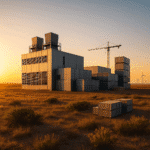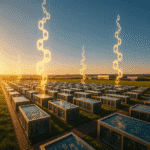Key Takeaways
- Custom GPU technologies offering 20–25% lower power consumption are giving AI infrastructure providers a clear competitive advantage.
- Companies like Mistral AI are adopting energy-efficient compute clusters to support ambitious AI initiatives while reducing operational costs.
- Innovations such as liquid cooling and dynamic voltage scaling materially reduce data centre energy demand and enable scalable infrastructure.
- Investment in power-efficient AI data centres is expected to reshape global infrastructure markets, potentially exceeding $100 billion by 2030.
- Energy-efficient architectures are becoming strategically important in regions with high electricity volatility, aligning with both cost and sustainability goals.
In the rapidly evolving landscape of artificial intelligence, energy efficiency in data centre operations has emerged as a critical differentiator for technology providers. Companies that can deliver GPU technologies with substantially lower power consumption are gaining a competitive edge, reducing operational costs by as much as 20-25% compared to standard offerings. This advantage is particularly appealing to fast-growing AI players, such as Mistral AI, which are scaling their compute-intensive workloads amid soaring global energy demands.
The Rising Tide of AI-Driven Energy Consumption
As AI models grow in complexity, the power requirements for training and inference have skyrocketed. Data centres dedicated to AI tasks now consume vast amounts of electricity, with projections indicating that global data centre energy use could double by 2030. A key factor in this surge is the deployment of high-performance GPUs, which are essential for handling the parallel processing demands of large language models and other AI applications. However, innovations in custom GPU designs and optimised data centre architectures are beginning to mitigate these costs, offering reductions in power draw that translate directly into financial savings.
Recent analyses highlight that advanced GPU setups can achieve up to 20% lower power consumption than conventional systems. This efficiency stems from tailored hardware integrations, improved cooling mechanisms, and software optimisations that minimise idle power usage. For instance, in high-density AI clusters, where racks of GPUs operate continuously, even marginal improvements in energy efficiency can yield significant cost reductions over time. Industry reports suggest that the total cost of ownership for GPU operations—including electricity, maintenance, and infrastructure—can drop by 20–25% with these enhancements, making such technologies highly attractive for AI firms under pressure to manage expenses while expanding capabilities.
Technological Underpinnings of Cost Advantages
At the heart of these savings are custom technologies that address the inefficiencies inherent in off-the-shelf GPU solutions. Traditional data centres often grapple with uneven power distribution and thermal management, leading to higher operational overheads. In contrast, bespoke systems incorporate features like dynamic voltage scaling and advanced power gating, which allow GPUs to consume less energy during low-load periods without sacrificing performance. This is particularly relevant for AI workloads, which can fluctuate dramatically, from intensive training phases to sporadic inference tasks.
Moreover, the integration of energy-efficient designs extends to the data centre level. Innovations in liquid cooling and modular architectures reduce the need for power-hungry air conditioning, further lowering consumption. According to insights from energy-focused studies, these approaches can stabilise power demands, preventing spikes that strain grids and inflate costs. For AI companies, this means not only lower bills but also greater scalability, as they can deploy larger clusters without proportional increases in energy expenditure.
Attracting AI Innovators: The Case of Mistral AI
Fast-growing AI entities are increasingly drawn to providers offering these cost efficiencies, recognising that optimised power usage is key to sustainable growth. Mistral AI, a prominent player in the development of open-source large language models, exemplifies this trend. The company has pursued partnerships and infrastructure solutions that prioritise energy-efficient compute environments to support its ambitious projects in areas like defence technology, pharmaceutical discovery, and financial markets.
Mistral AI’s strategy involves building sovereign AI stacks that leverage high-performance, low-power GPU clusters. By aligning with technologies that cut power consumption by around 20%, Mistral can accelerate its model training and deployment while keeping costs in check. This is crucial in a sector where electricity can account for up to 40% of data centre operating expenses. The appeal is evident in recent developments, such as the launch of energy-efficient AI clusters in regions like France, designed to handle domain-specific AI efforts with minimal environmental impact.
Beyond Mistral, the broader AI ecosystem is witnessing a shift towards providers that promise these advantages. Companies investing in next-generation data centres are positioning themselves to capture demand from AI startups and enterprises alike, fostering an environment where cost savings enable faster innovation cycles.
Market Implications and Analyst Forecasts
From a financial perspective, the emphasis on power-efficient GPU technologies is reshaping investment landscapes. Analyst models project that the global market for AI data centre infrastructure could exceed $100 billion by 2030, driven in part by demand for cost-optimised solutions. Firms that lead in this space may see enhanced margins, with potential revenue growth of 15–20% annually as adoption accelerates.
Sentiment from credible sources, such as reports by Uptime Intelligence, remains cautiously optimistic, noting that while AI’s energy footprint is substantial, innovations could cap global power consumption increases at manageable levels. Preliminary calculations suggest the impact on worldwide data centre energy use might rise quickly but stabilise through efficiency gains.
Looking ahead, challenges like grid capacity constraints and regulatory scrutiny over energy costs could amplify the value of these technologies. In scenarios modelled by industry experts, widespread adoption of 20% more efficient systems could reduce sector-wide energy demands by hundreds of terawatt-hours annually, providing a buffer against rising electricity prices.
Broader Economic and Environmental Context
The push for lower GPU and data centre power consumption also intersects with global sustainability goals. With AI data centres straining power grids, as noted in analyses from sources like SemiAnalysis, there is growing pressure to balance innovation with environmental responsibility. Technologies offering 20–25% cost reductions not only bolster bottom lines but also align with carbon reduction targets, potentially qualifying for green incentives.
In Europe, where energy costs are particularly volatile, this dynamic is attracting investments in large-scale AI campuses. For example, plans for gigawatt-scale facilities in Paris underscore the strategic importance of efficient designs in drawing AI players. Such developments could redefine competitive advantages, favouring regions and companies that prioritise energy optimisation.
Ultimately, as AI continues to permeate industries, the ability to deliver cost-effective, power-efficient compute will determine market leaders. For investors, tracking advancements in this area offers insights into resilient growth stories amid an energy-constrained future.
References
- 174 Power Global. (n.d.). How are companies building AI-ready data centers? The infrastructure race reshaping digital computing. https://174powerglobal.com/blog/how-are-companies-building-ai-ready-data-centers-the-infrastructure-race-reshaping-digital-computing
- AICerts.ai. (n.d.). Tech companies: Data centre energy costs. https://aicerts.ai/news/tech-companies-data-center-energy-costs
- CoreSite. (n.d.). AI and the data center: Driving greater power density. https://www.coresite.com/blog/ai-and-the-data-center-driving-greater-power-density
- DatacenterDynamics. (n.d.). Generative AI and global power consumption: High, but not that high. https://www.datacenterdynamics.com/en/opinions/generative-ai-and-global-power-consumption-high-but-not-that-high/
- DatacenterDynamics. (n.d.). MGX, Bpifrance, Nvidia and Mistral AI plan 1.4GW Paris data center campus. https://www.datacenterdynamics.com/en/news/mgx-bpifrance-nvidia-and-mistral-ai-plan-14gw-paris-data-center-campus/
- DevSustainability. (2024). Expect more overestimates of AI energy. https://www.devsustainability.com/p/expect-more-overestimates-of-ai-energy
- Intel Corporation. (n.d.). What is data center GPU? https://www.intel.com/content/www/us/en/products/docs/discrete-gpus/data-center-gpu/what-is-data-center-gpu.html
- Mistral AI. (n.d.). Mistral Compute. https://mistral.ai/news/mistral-compute
- Mistral AI. (n.d.). Homepage. https://mistral.ai/
- NetworkWorld. (n.d.). Next-gen AI chips will draw 15,000W each, redefining power, cooling and data center design. https://networkworld.com/article/4008275/next-gen-ai-chips-will-draw-15000w-each-redefining-power-cooling-and-data-center-design.html
- OpenPR. (n.d.). AI data center power consumption market is going to boom: Major players and trends. https://openpr.com/news/4128414/ai-data-center-power-consumption-market-is-going-to-boom-major
- Robotics and Automation News. (2025, June 18). AI data centers: Powering the future of artificial intelligence. https://roboticsandautomationnews.com/2025/06/18/ai-data-centers-powering-the-future-of-artificial-intelligence/92300/
- SemiAnalysis. (2024, March 13). The AI datacenter energy dilemma: The race. https://semianalysis.com/2024/03/13/ai-datacenter-energy-dilemma-race/
- Unite.AI. (n.d.). GPU data centers strain power grids: Balancing AI innovation and energy consumption. https://www.unite.ai/gpu-data-centers-strain-power-grids-balancing-ai-innovation-and-energy-consumption/
- @aitech. (2024). AI cooling innovations. https://x.com/AITECHio/status/1874697240020693055
- @benbajarin. (2024). Data center energy insights. https://x.com/BenBajarin/status/1952512393201975602
- @cristianogiardina. (2024). Power requirement estimates. https://x.com/CrisGiardina/status/1830697234939175314
- @danielroberts. (2024). AI energy economics. https://x.com/danroberts0101/status/1902756324385189984
- @fatihcetinkaya. (2024). Cost-saving examples in AI compute. https://x.com/devfacet/status/1748801677921063317
- @tiborblaho. (2024). Mistral AI clusters. https://x.com/btibor91/status/1888684558343901262














